Porter-Cable PCB270TS User Manual
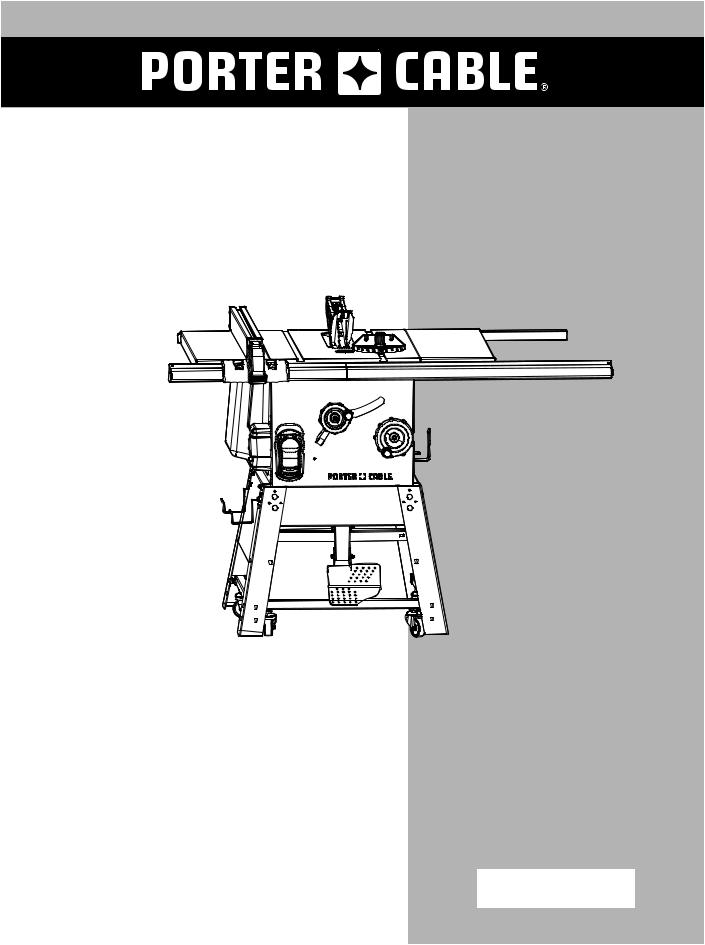
10 IN. (254 MM) STATIONARY TABLE SAW BANC DE SCIE 254 MM (10 PO)
SIERRA DE MESA 254 MM (10 PULG.)
Instruction Manual
Manuel d’instructions
Manual de instrucciones
www.portercable.com
INSTRUCTIVO DE OPERACIÓN, CENTROS DE SERVICIO Y PÓLIZA DE GARANTÍA.
 ADVERTENCIA: LÉASE ESTE
ADVERTENCIA: LÉASE ESTE
INSTRUCTIVO ANTES DE USAR EL PRODUCTO.
CATALOG NUMBER
PCB270TS

TABLE OF CONTENTS
SECTION |
PAGE |
PRODUCT SPECIFICATIONS .......................................................................................................................................... |
2 |
CALIFORNIA PROPOSITION 65 ...................................................................................................................................... |
2 |
SAFETY GUIDELINES - DEFINITIONS ............................................................................................................................ |
3 |
POWER TOOL SAFETY ................................................................................................................................................... |
4 |
TABLE SAW SAFETY ....................................................................................................................................................... |
5 |
ELECTRICAL REQUIREMENTS AND SAFETY ............................................................................................................... |
7 |
TOOLS NEEDED FOR ASSEMBLY ................................................................................................................................. |
8 |
CARTON CONTENTS ...................................................................................................................................................... |
9 |
KNOW YOUR TABLE SAW............................................................................................................................................... |
11 |
GLOSSARY OF TERMS.................................................................................................................................................... |
12 |
ASSEMBLY AND ADJUSTMENTS.................................................................................................................................... |
13 |
OPERATION ..................................................................................................................................................................... |
23 |
MAINTENANCE ................................................................................................................................................................ |
29 |
TROUBLESHOOTING GUIDE........................................................................................................................................... |
30 |
ACCESSORIES AND ATTACHMENTS ............................................................................................................................ |
31 |
PARTS LIST ...................................................................................................................................................................... |
33 |
WARRANTY ...................................................................................................................................................................... |
38 |
PRODUCT SPECIFICATIONS |
|
MOTOR |
|
SAW |
|
Type ........................................... |
Induction |
Table Size................................... |
27-1/8 in. x 20-1/8 in. |
Amps |
|
|
(688 mm x 512 mm) |
15 / 7.5 |
Table Extensions......................... |
Right & Left |
|
Voltage ....................................... |
120 / 240 |
Extension Fence Capacity........... |
30 in. (762 mm) Right |
Hz............................................... |
60 |
Blade Size.................................... |
10 in. (254 mm) |
RPM (no load)............................. |
3450 |
Blade Arbor.................................. |
5/8 in. (15.9 mm) |
Overload Protection................... |
YES |
CUTTING CAPACITY |
|
MITER GAUGE |
YES |
Maximum Cut Depth @ 90°......... |
3-1/2in.(88.9 mm) |
RIP FENCE |
YES |
Maximum Cut Depth @ 45°......... |
2-1/4 in.(57.1 mm) |
|
|
Maximum Dado Cut Width........... |
13/16 in.(20.6 mm) |
|
|
Maximum Dado Blade Diameter.. 8 in. (203.2mm) |
|
! WARNING
To avoid electrical hazards, fire hazards or damage to the tool, use proper circuit protection. Use a seperate electrical
circuit for your tools. To avoid electrical hazards, fire hazards or damage to the table saw, use proper circuit protection. This table saw is wired at the factory for 110-120/220-240 Volt operation. It must be connected to a 110-120 Volt / 15
Ampere or 220-240 Volt / 7.5 Ampere time delay fuse or circuit breaker. To avoid shock or fire, replace power cord immediately if it is worn, cut or damaged in any way.
CALIFORNIA PROPOSITION 65
! WARNING
Some dust created by power sanding, sawing, grinding, drilling and other construction activities contains chemicals known to the state of California to cause cancer, birth defects or other reproductive harm. Some examples of these chemicals are:
•Lead from lead-based paints,
•Crystalline silica from bricks and cement and other masonry products, and
•Arsenic and chromium from chemically-treated lumber.
Your risk from these exposures varies, depending on how often you do this type of work. To reduce your exposure to these chemicals: work in a well ventilated area, and work with approved safety equipment, such as those dust masks that are specially designed to filter out microscopic particles.
Avoid prolonged contact with dust from power sanding, sawing, grinding, drilling, and other construction activities. Wear protective clothing and wash exposed areas with soap and water. Allowing dust to get into your mouth, eyes, or lay on the skin may promote absorption of harmful chemicals.
|
Use of this tool can generate and/or disperse dust, which may cause serious and permanent |
||
! WARNING |
|||
respiratory or other injury. Always use NIOSH/OSHA approved respiratory protection |
|||
|
|||
appropriate for the dust exposure. Direct particles away from face and body. |
|
||
2009/12 |
– 2 – |
Printed in Taiwan |
|
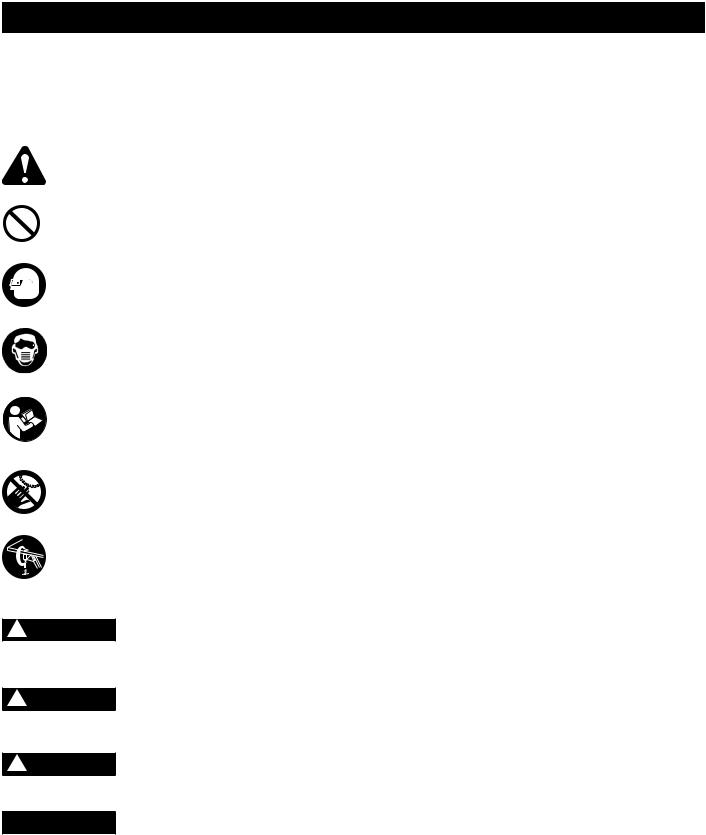
SAFETY GUIDELINES - DEFINITIONS
WARNING ICONS
Your power tool and its Instruction Manual may contain “WARNING ICONS” (a picture symbol intended to alert you to, and/or instruct you how to avoid, a potentially hazardous condition). Understanding and heeding these symbols will help you operate your tool better and safer. Shown below are some of the symbols you may see.
SAFETY ALERT: Precautions that involve your safety.
PROHIBITION
WEAR EYE PROTECTION: Always wear safety goggles or safety glasses with side shields.
WEAR RESPIRATORY AND HEARING PROTECTION: Always wear respiratory and hearing protection.
READ AND UNDERSTAND INSTRUCTION MANUAL: To reduce the risk of injury, user and all bystanders must read and understand instruction manual before using this product.
KEEP HANDS AWAY FROM BLADE: Failure to keep your hands away from the blade will result in serious personal injury.
SUPPORT AND CLAMP WORK
!DANGER
!WARNING
!CAUTION
CAUTION
DANGER: Indicates an imminently hazardous situation which, if not avoided, will result in death or serious injury.
WARNING: Indicates a potentially hazardous situation which, if not avoided, could result in death or serious injury.
CAUTION: Indicates a potentially hazardous situation which, if not avoided, may result in minor or moderate injury.
CAUTION: Used without the safety alert symbol indicates a potentially hazardous situation which, if not avoided, may result in property damage.
– 3 –
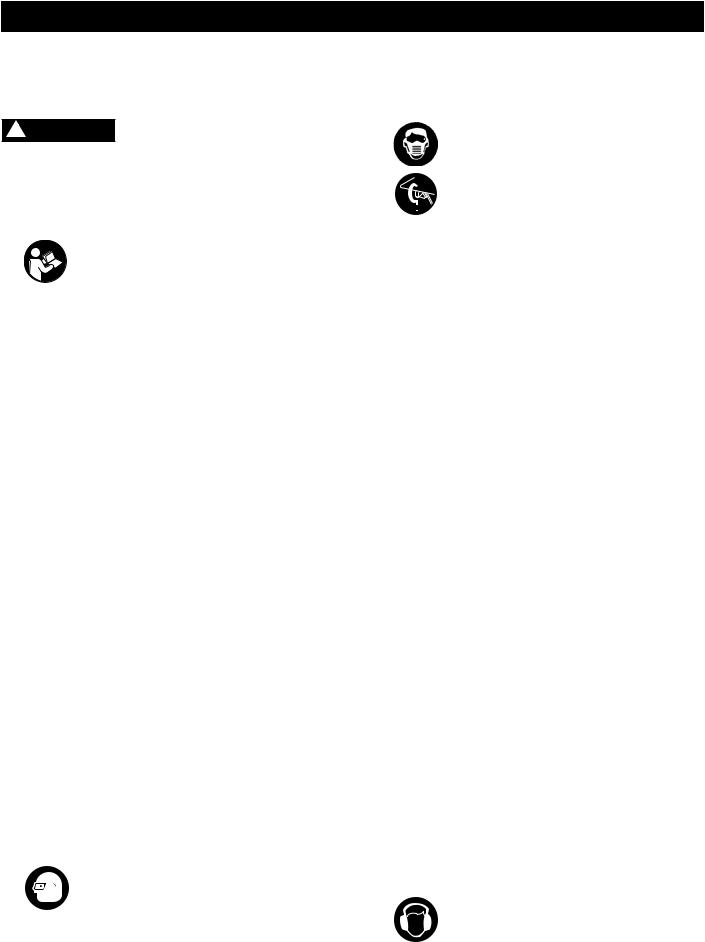
POWER TOOL SAFETY
GENERAL SAFETY INSTRUCTIONS
BEFORE USING THIS POWER TOOL
Safety is a combination of common sense, staying alert and knowing how to use your power tool.
!WARNING
•To avoid mistakes that could cause serious injury, do not plug the tool in until you have read and understood the following.
•Read all instructions before operating product. Failure to follow all instructions listed below may result in electric shock, fire and/or serious injury.
1. READ and become familiar with the entire
Instruction Manual. LEARN the tool’s
application, limitations and possible hazards.
2. KEEP GUARDS IN PLACE and in working order.
3. REMOVE ADJUSTING KEYS AND WRENCHES. Form the habit of checking to see that keys and adjusting wrenches are removed from the tool before
turning ON.
4. KEEP WORK AREA CLEAN. Cluttered areas and benches invite accidents.
5. DO NOT USE IN DANGEROUS ENVIRONMENTS. Do not use power tools in damp locations, or expose them to rain or snow. Keep work area well lit.
6. KEEP CHILDREN AWAY. All visitors and bystanders should be kept a safe distance from work area.
7. MAKE WORKSHOP CHILD PROOF with padlocks, master switches or by removing starter keys.
8. DO NOT FORCE THE TOOL. It will do the job better and safer at the rate for which it was designed.
9. USE THE RIGHT TOOL. Do not force the tool or an attachment to do a job for which it was not designed.
10. USE PROPER EXTENSION CORDS. Make sure your extension cord is in good condition. When using an extension cord, be sure to use one heavy enough to carry the current your product will draw. An undersized cord will result in a drop in line voltage and in loss of power which will cause the tool to overheat. The table on page 7 shows the correct size to use depending on cord length and nameplate ampere rating. If in doubt, use the next heavier gauge. The smaller the gauge number, the heavier the cord.
11. WEAR PROPER APPAREL. Do not wear loose clothing, gloves, neckties, rings, bracelets or other jewelry which may get caught in moving parts. Nonslip footwear is recommended. Wear protective hair covering to contain long hair.
12. ALWAYS WEAR EYE PROTECTION.
Any power tool can throw foreign objects into the eyes and could cause permanent eye damage. ALWAYS wear Safety Goggles (not
glasses) that comply with ANSI Safety standard
– 4 –
Z87.1. Everyday eyeglasses have only impact– resistant lenses. They ARE NOT safety glasses. NOTE: Glasses or goggles not in compliance with ANSI Z87.1 could seriously injure you when they break.
13. WEAR A FACE MASK OR DUST MASK. Sawing operation produces dust.
14. SECURE WORK. Use clamps or a vise to
 hold work when practical. It is safer than
hold work when practical. It is safer than

 using your hand and it frees both hands to
using your hand and it frees both hands to
operate the tool.
15.DISCONNECT TOOLS FROM POWER SOURCE before servicing, and when changing accessories such as blades, bits and cutters.
16.REDUCE THE RISK OF UNINTENTIONAL STARTING. Make sure switch is in the OFF position before plugging the tool in.
17.USE RECOMMENDED ACCESSORIES. Consult this Instruction Manual for recommended
accessories. The use of improper accessories may cause risk of injury to yourself or others.
18.NEVER STAND ON THE TOOL. Serious injury could occur if the tool is tipped or if the cutting tool is unintentionally contacted.
19.CHECK FOR DAMAGED PARTS. Before further use of the tool, a guard or other part that is damaged should be carefully checked to determine that it will operate properly and perform its intended function
–check for alignment of moving parts, binding of moving parts, breakage of parts, mounting and any other conditions that may affect its operation. A guard or other part that is damaged should be properly repaired or replaced.
20.NEVER LEAVE THE TOOL RUNNING UNATTENDED. TURN THE POWER “OFF”. Do not walk away from a running tool until the blade comes to a complete stop and the tool is unplugged from the power source.
21.DO NOT OVERREACH. Keep proper footing and balance at all times.
22.MAINTAIN TOOLS WITH CARE. Keep tools sharp and clean for best and safest performance. Follow instructions for lubricating and changing accessories.
23.DO NOT use power tool in presence of flammable liquids or gases.
24.DO NOT operate the tool if you are under the influence of any drugs, alcohol or medicationn that could affect your ability to use the tool properly.
25.Dust generated from certain materials can be hazardous to your health. Always operate saw in well-ventilated area and provide for proper dust removal.
26.WEAR HEARING PROTECTION to reduce the risk of induced hearing loss.

TABLE SAW SAFETY
1.ALWAYS USE SAW BLADE GUARD, riving knife and anti-kickback pawls for every through–sawing operation. Through–sawing operations are those in which the blade cuts completely through the workpiece when ripping or crosscutting. Always be sure blade guard is tightened securely.
2.ALWAYS HOLD WORK FIRMLY against the miter gauge or rip fence.
3.ALWAYS USE a push stick, especially when ripping narrow stock. Refer to ripping instructions in this Instruction Manual where the push stick is covered in detail. A pattern for making your own push stick is included on page 32.
4.NEVER PERFORM ANY OPERATION FREEHAND, which means using only your hands to support or guide the workpiece. Always use either the fence or the miter gauge to position and guide the work.
! WARNING
FREEHAND CUTTING IS THE MAJOR CAUSE OF KICKBACK AND FINGER/HAND AMPUTATIONS.
5.NEVER STAND or have any part of your body in line with the path of the saw blade. Keep your hands out of the saw blade path.
6.NEVER REACH behind or over the cutting tool for any reason.
7.REMOVE the rip fence when crosscutting.
8.DO NOT USE a molding head with this saw.
9.FEED WORK INTO THE BLADE against the direction of rotation only.
10.NEVER use the rip fence as a cut-off gauge when crosscutting.
11.NEVER ATTEMPT TO FREE A STALLED SAW BLADE without first turning the saw OFF. Turn power switch OFF immediately to prevent motor damage.
12.PROVIDE ADEQUATE SUPPORT to the rear
and the sides of the saw table for long or wide workpieces.
13.AVOID KICKBACKS (work thrown back towards you) by keeping the blade sharp, the rip fence parallel to the saw blade and by keeping the riving knife, anti-kickback pawls and guards in place, aligned and functioning. Do not release work before passing it completely beyond the saw blade. Do not rip work that is twisted, warped or does not have a straight edge to guide it along the fence.
14.AVOID AWKWARD OPERATIONS and hand positions where a sudden slip could cause your hand to move into the saw blade.
15.NEVER USE SOLVENTS to clean plastic parts. Solvents could possibly dissolve or otherwise damage the material. Only a soft damp cloth should be used to clean plastic parts.
16.MOUNT your table saw on a bench or stand
before performing any cutting operations. Refer to ASSEMBLY AND ADJUSTMENTS on page 13. Secure tool properly to prevent unexpected movement.
17.NEVER CUT METALS or materials that may make hazardous dust.
18.ALWAYS USE IN A WELL-VENTILATED AREA. Remove sawdust frequently. Clean out sawdust from the interior of the saw to prevent a potential fire hazard. Attach a vacuum to the dust port for additional sawdust removal.
19.NEVER LEAVE THE SAW RUNNING UNATTENDED. Do not leave the saw until the blade comes to a complete stop.
20.For proper operation follow the instructions in
this Instruction Manual entitled ASSEMBLY AND ADJUSTMENTS (Page 13). Failure to provide sawdust fall-through and removal hole will allow sawdust to build up in the motor area resulting in a fire hazard and potential motor damage.
21.USE ONLY saw blades recommended with warning that the riving knife shall not be thicker than the width of the groove cut by the saw blade and not thinner than the body of the saw blade.
22.USE PUSH-STICK OR PUSH BLOCK to feed the workpiece past the saw blade. The push-stick
or push block should always be stored with the machine when not in use.
23.DIRECTION OF FEED. Feed work into a blade against the direction of rotation of the blade.
– 5 –

TABLE SAW SAFETY
SAW BLADE GUARD ASSEMBLY, ANTI-KICKBACK ASSEMBLY AND RIVING KNIFE
Your table saw is equipped with a blade guard assembly, anti-kickback assembly and riving knife that covers the blade and reduces the possibility of accidental blade contact. The riving knife is a flat plate that fits into the cut made by the saw blade and effectively fights kickback by lessening the tendency of the blade to bind in the cut. The blade guard assembly and anti-kickback assembly can only be used when making through cuts that sever the wood. When making rabbets and other cuts that make non through cuts, the blade guard assembly and anti-kickback assembly must be removed and riving knife lowered to the non through cut position marked on the riving knife. Two anti-kickback pawls are located on the sides of the riving knife that allow the wood to pass through the blade in the cutting direction but reduce the possibility of the material being thrown backwards toward the operator. Use all components of the guarding system (blade guard assembly, riving knife and antikickback assembly) for every operation for which they can be used including all through cutting. If you elect not to use any of these components for a particular application exercise additional caution regarding control of the workpiece, the use of push sticks, the position of your hands relative to the blade, the use of safety glasses, the means to avoid kickback and all other warnings contained in this manual and on the saw itself. Replace the guarding systems as soon as you return to thru-cutting operations. Keep the guard assembly
in working order.
KICKBACKS
KICKBACKS: Kickbacks can cause serious injury. A kickback occurs when a part of the workpiece binds between the saw blade and the rip fence, or other fixed object, and rises from the table and is thrown toward the operator. Kickbacks can be avoided by attention to
the following conditions.
How to Avoid Them and Protect Yourself from Possible Injury:
a.Be certain that the rip fence is parallel to the saw blade.
b.Do not rip by applying the feed force to the section of the workpiece that will become the cut-off (free) piece. Feed force when ripping should always be applied between the saw blade and the fence; use a push stick for narrow work, 6 in. (152 mm) wide or less.
c.Keep saw blade guard assembly, riving knife and antikickback assembly in place and operating properly. If anti-kickback assembly is not operational, return your unit to the nearest authorized service center for repair. The riving knife must be in alignment with the
saw blade and the anti-kickback assembly must stop a kickback once it has started. Check their action before ripping by pushing the wood under the antikickback assembly. The teeth must prevent the wood from being pulled toward the front of the saw.
d.Plastic and composite (like hardboard) materials may be cut on your saw. However, since these are usually quite hard and slippery, the anti-kickback pawls may not stop a kickback. Therefore, be especially attentive to following proper set up and cutting procedures for ripping.
e.Use saw blade guard assembly, anti-kickback assembly and riving knife for every operation for which it can be used, including all through-sawing.
f.Push the workpiece past the saw blade prior to release.
g.Never rip a workpiece that is twisted or warped, or does not have a straight edge to guide along the fence.
h.Never saw a large workpiece that cannot be controlled.
i.Never use the fence as a guide or length stop when crosscutting.
j.Never saw a workpiece with loose knots, flaws, nails or other foreign objects.
k.Never rip a workpiece shorter than 10 in. (254 mm).
l.NEVER use a dull blade – replace or have resharpened.
m.NEVER use a rip fence and miter gauge together.
n.Keep hands out of saw blade.
– 6 –
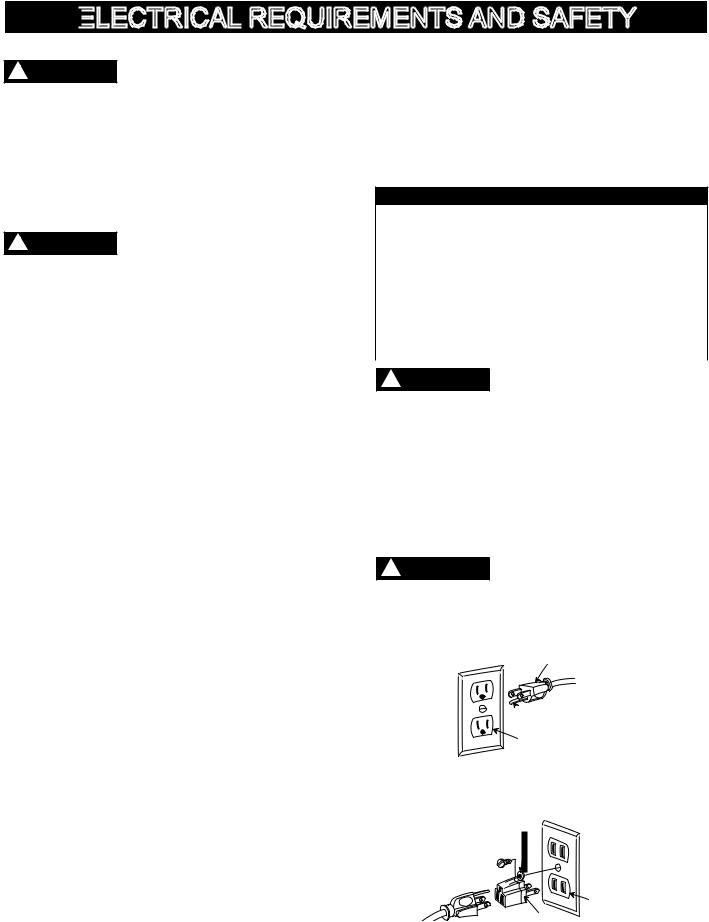
ELECTRICAL

 REQUIREMENTS AND SAFETY
REQUIREMENTS AND SAFETY
POWER SUPPLY AND MOTOR SPECIFICATIONS
! WARNING
To avoid electrical hazards, fire hazards, or damage to the tool, use proper circuit protection. Use a seperate electrical circuit for your tool. Your saw is wired at the factory for 120 V operation. Connect to a 120 V, 15 Amp circuit and use a 15 Amp time delay fuse or circuit breaker. To avoid shock or fire, if power cord is worn, cut, or damaged in any way, have it replaced immediately.
GROUNDING INSTRUCTIONS
! WARNING
This tool must be grounded while in use to protect the operator from electrical shock.
IN THE EVENT OF A MALFUNCTION OR BREAKDOWN, grounding provides a path of least resistance for electric currents and reduces the risk of electric shock. This tool is equipped with an electrical cord that has an equipment-grounding conductor and a grounding plug. The plug must be plugged into a matching receptacle that is properly installed and grounded in accordance with all local codes and ordinances.
DO NOT MODIFY THE PLUG PROVIDED. If it will not fit the receptacle, have the proper receptacle installed by a qualified electrician.
IMPROPER CONNECTION of the equipment grounding conductor can result in risk of electric shock. The conductor with the green insulation (with or without yellow stripes) is the equipment grounding conductor. If repair or replacement of the electrical cord or plug is necessary, do not connect the equipment grounding conductor to a live terminal.
CHECK with a qualified electrician or service person if you do not completely understand the grounding instructions, or if you are not certain the tool is properly grounded.
USE only 3-wire extension cords that have three-pronged grounding plugs with three-pole receptacles that accept the tool’s plug. Repair or replace damaged or worn cords immediately.
Use a separate electrical circuit for your tool. This circuit must not be less than #14 wire and should be protected with a 15 Amp time lag fuse. Before connecting the motor to the power line, make sure the switch is in the off position and the electric current is rated the same as the current stamped on the motor nameplate. Running at a lower voltage will damage the motor.
GUIDELINES FOR EXTENSION CORDS
USE THE PROPER EXTENSION CORD. Make sure your extension cord is in good condition. Use an extension cord heavy enough to carry the current your product will draw. An undersized cord will cause a drop in line voltage resulting in loss of power, overheating
and burning out of the motor. The table below shows the correct size to use depending on cord length and nameplate ampere rating. If in doubt, use the next heavier gauge. The smaller the gauge number, the heavier the cord.
Make sure your extension cord is properly wired and in good condition. Always replace a damaged extension cord or have it repaired by a qualified technician before using it. Protect your extension cords from sharp objects, excessive heat and damp or wet areas.
MINIMUM GAUGE FOR EXTENSION CORDS (AWG)
Ampere Rating |
|
Total length of Cord |
|
||||
|
|
|
|
|
|
|
|
More Than |
Not More Than |
120V |
25 |
50 |
100 |
150 |
ft. |
|
|
|
(7.62 |
15.24 |
30.48 |
45.72 |
m) |
|
|
240V |
50 |
100 |
200 |
300 |
ft. |
|
|
|
(15.24 30.48 60.96 91.44 m) |
||||
|
|
|
|
||||
|
|
|
AWG - American Wire Gauge |
||||
|
|
|
|
|
|
|
|
0 |
6 |
|
18 |
16 |
16 |
14 |
|
|
|
|
|
|
|
|
|
6 |
10 |
|
18 |
16 |
14 |
12 |
|
|
|
|
|
|
|
|
|
10 |
12 |
|
16 |
16 |
14 |
12 |
|
|
|
|
|
|
|
||
12 |
16 |
|
14 |
12 |
Not Recommended |
||
|
|
|
|
|
|
|
|
! WARNING
This tool is for indoor use only. Do not expose to rain or use in damp locations.
This tool is intended for use on a circuit that has a receptacle like the one illustrated in Fig. 1. Fig. 1 shows a three-pronged electrical plug and receptacle that has a grounding conductor. If a properly grounded receptacle is not available, an adapter (Fig. 2) can be used to temporarily connect this plug to a two-contact grounded receptacle. The adapter (Fig. 2) has a rigid lug extending from it that MUST be connected to a permanent earth ground, such as a properly grounded receptacle box.
! CAUTION
In all cases, make certain the receptacle is properly grounded. If you are not sure, have a qualified electrician check the receptacle.
Fig. 1 |
Three-Pronged Plug |
|
 Grounding Prong
Grounding Prong
Properly Grounded
Three-Pronged Receptacle
Fig. 2
Grounding Lug
Make sure this is connected to a 
 known ground.
known ground.
Two-Pronged
Adapter  Receptacle
Receptacle
– 7 –

240 VOLT SINGLE PHASE OPERATION
! WARNING
To avoid injury, disconnect the motor from power source outlet before reconnecting the wire.
The motor supplied with your machine is a dual voltage, 120/240 volt motor. It is shipped ready-to-run for 120 volt operation. However, it can be converted for 240 volt operation, reconnect the motor wire as the wiring diagram on page 28.
A qualified electrician should do the conversion, or the machine can be taken to an Authorized Service Center. When completed, the machine must conform to the National Electric Code and all local codes and ordinances.
The machine is converted by re-wiring the motor for 240 volts, installing a 240 volt plug on the power supply cord and replacing the switch with one that is rated for 240 volt operation.
Be sure the 240 volt plug is only used in an outlet having the same configuration as the plug illustrated in Fig. 1. No adapter should be used with the 240 volt plug.
! CAUTION
In all cases, make certain that the receptacle in question is properly grounded. If you are not sure, have a qualified electrician check the receptacle.
TOOLS NEEDED FOR ASSEMBLY
ASSEMBLY
Supplied |
Not Supplied |
Blade wrench |
Medium screwdriver |
6 mm hex key |
Phillips screwdriver |
|
Straight edge |
|
Adjustable wrench |
|
10, 13, 17 mm hex wrench |
|
Combination square |
– 8 –

CARTON CONTENTS
UNPACKING AND CHECKING CONTENTS
Carefully unpack the table saw and all its parts, and compare against the list below and the illustration on the next page. With the help of an assistant place the saw on a secure surface and examine it carefully.
!WARNING
•To avoid injury from unexpected starting or electrical shock, do not plug the power cord into a source of power during unpacking and assembly. The cord must remain unplugged whenever you are adjusting/ assembling the saw.
•The saw is heavy and should be lifted with care. Get the assistance of someone to lift and move the saw.
•If any part is missing or damaged, do not attempt to assemble the table saw, or plug in the power cord until the missing or damaged part is correctly replaced.
TABLE OF LOOSE PARTS
STAND
ITEM DESCRIPTION |
QUANTITY |
|
A. |
Leg set |
1 set |
|
Front right leg - no. 2 |
1 |
|
Rear right leg - no. 3 |
1 |
|
Front left leg - no. 5 |
1 |
|
Rear left leg - no. 6 |
1 |
B. |
Right leg support - no. 1 |
1 |
|
Left leg support - no. 4 |
1 |
C. |
Leg assembly hardware bag |
1 set |
|
Square neck bolts |
22 |
|
Hex nuts |
22 |
D. |
Front leg support - no. 7 |
1 |
E. |
Rear top leg support - no. 8 |
1 |
F. |
Rear bottom leg support - no. 9 |
1 |
Foot pads |
1 set |
|
G. |
Caster assembly bracket |
1 |
H. |
Front casters / rear casters |
2 each |
I. |
Caster assembly hardware bag |
1 set |
|
Socket hex bolt - long |
1 |
|
Socket hex bolt |
2 |
|
Socket hex bolt - short |
2 |
|
Hex nuts |
3 |
|
6 mm hex key |
1 |
ITEM DESCRIPTION |
QUANTITY |
|
J. |
Storage parts |
|
|
Miter guage storage |
1 |
|
Rip fence storage |
1 set |
|
Power cord storage |
1 set |
|
Blade guard assembly storage |
1 set |
K. |
Storage parts hardware |
1 set |
|
Screws - long |
2 |
|
Screws - short |
2 |
|
Nuts |
4 |
|
Screws with washers |
6 |
TABLE OF LOOSE PARTS
TABLE SAW
ITEM DESCRIPTION |
QUANTITY |
||
L. |
Table saw assembly |
1 |
|
M. |
Right / left table extension |
1 each |
|
N. |
Front table extension rail |
1 set |
|
O. |
Rear table extension rail |
1 set |
|
P. |
Hex bolts |
4 |
|
Q. |
Table extension hardware bag |
1 set |
|
R. |
Front rail covers |
1 set |
|
S. |
Front rail hardware bag |
1 set |
|
|
Hex bolts - long |
4 |
|
|
Hex bolts - short |
2 |
|
T. |
Square nuts |
6 |
|
Rear rail hardware bag |
1 set |
||
|
Hex bolts |
6 |
|
|
Hex nuts |
2 |
|
U. |
Handwheel, dome nut, handle, nut |
1 each |
|
V. |
Riving knife |
1 set |
|
W. |
Anti-kickback pawl |
1 |
|
X. |
Blade guard |
1 |
|
Y. |
Miter gauge |
1 |
|
Z. |
Rip fence |
1 each |
|
AA. |
Blade wrench |
1 |
|
BB. |
Push stick |
1 |
|
– 9 –
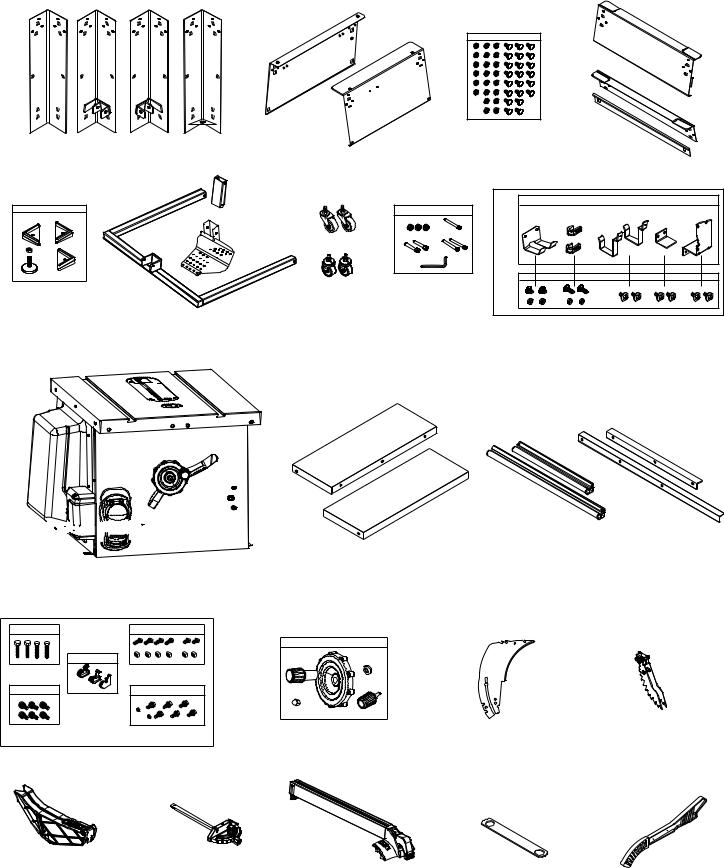
UNPACKING YOUR TABLE SAW
5 |
6 |
3 |
2 |
|
D |
7 |
|
|
|
|
4 |
|
|
|
|
|
|
1 |
|
8 |
|
|
|
|
C |
|
9 |
|
|
A |
B |
|
E |
|
|
|
|
J |
F |
G |
H |
I |
K |
L 













 M
M
P |
S |
|
|
R |
|
Q |
T |
U |
NO
V W
X |
Y |
Z |
AA |
BB |
|
|
|
– 10 – |
|
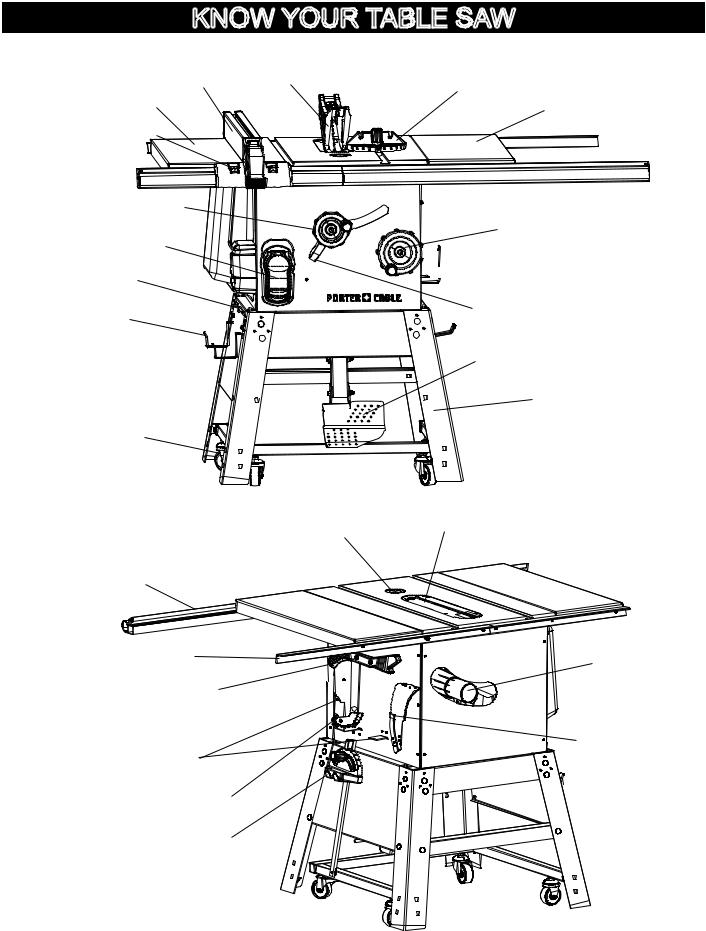
KNOW YOUR TABLE SAW
SAW
Rip fence Table extension (left)
Micro-adjustment rollers
Blade elevation handwheel
ON/OFF switch with key
Power cord storage
Rip fence storage
Caster
Front rail
Blade guard |
Miter gauge |
|
Table extension (right)
Blade tilting handwheel

 Blade guard storage
Blade guard storage
Blade bevel lock handle
Pedal
Stand
Blade tilt scale |
Table insert |
|
Rear rail |
Dust port |
|
|
Blade wrench & |
|
push stick storage |
|
Blade guard storage |
Riving knife storage |
|
Anti-kickback pawl storage
Miter gauge storage
– 11 –
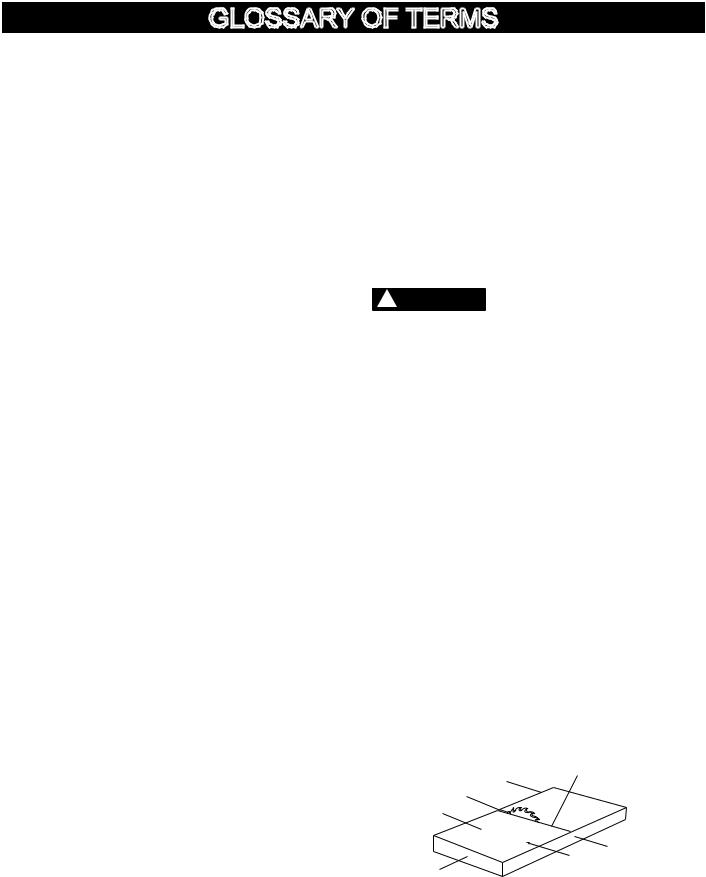
GLOSSARY OF
 TERMS
TERMS
ANTI-KICKBACK PAWLS – Prevents the workpiece from being kicked upward or back toward the front of the table saw by the spinning blade.
ARBOR – The shaft on which the blade or dado is mounted.
BEVEL CUT – An angle cut made through the face of the workpiece.
BLADE BEVEL SCALE – Measures the angle the blade is tilted when set for a bevel cut.
BLADE ELEVATION AND TILTING HANDWHEEL –
Raises and lowers the blade or tilts the blade to angle between 0o and 45o for bevel cuts.
BLADE GUARD – Clear plastic cover that positions itself over the blade while cutting.
COMPOUND CUT – A simultaneous bevel and miter cut.
CROSSCUT – A cut made across the width of the workpiece.
DADO – Special cutting blades that are used to cut grooves in a workpiece.
FEATHERBOARD – When ripping a workpiece on your table saw, this keeps it firmly and safely against the rip fence. It also helps prevent chatter, gouging, and dangerous kickback.
FREEHAND – Performing a cut without using a rip fence, miter gauge, hold down or other proper device to prevent the workpiece from twisting during the cutting operation.
GUM – A sticky sap from wood products. HEEL – Misalignment of the blade.
JAMB NUT – Nut used to lock another nut in place on a threaded rod or bolt.
KERF – The amount of material removed by the blade cut.
KICKBACK – Occurs when the saw blade binds in the cut and violently thrusts the workpiece back toward the operator.
MITER CUT – An angle cut made across the width of the workpiece.
MITER GAUGE – A guide used for crosscutting operations that slides in the table top channels (grooves) located on either side of the blade. It helps make accurate straight or angle crosscuts.
NON-THROUGH SAWING - refers to any cut that does not completely cut through the workpiece.
OVERLOAD RESET SWITCH – Protects the motor if it overloads during operation, provides a way to restart the saw.
PUSH STICK – Used to push workpieces when performing ripping operations.
PUSH BLOCK – Used for ripping operation when the workpiece is too narrow to use a push stick. Always use a push block for rip widths less than 2 in (50.8 mm).
RESAWING - flipping material to make a cut the saw is not capable of making in one pass.
! WARNING Resawing IS NOT recommended.
REVOLUTIONS PER MINUTE (RPM) – The number of turns completed by a spinning object in one minute.
RIP FENCE – A guide used for rip cutting which allows the workpiece to cut straight.
RIPPING – Cutting with the grain of the wood or along the length of the workpiece.
RIVING KNIFE – A metal piece of the guard assembly located behind and moves with the blade. Slightly thinner than the saw blade, it helps keep the kerf open and prevents kickback.
SAW BLADE PATH – The area of the workpiece or table top directly in line with the travel of the blade or the part of the workpiece that will be cut.
SET – The distance between two saw blade tips, bent outward in opposite directions to each other. The further apart the tips are, the greater the set.
TABLE INSERT – Insert that is removed from the table to install / remove blades. When dado cutting, a dado insert plate must be used.
THROUGH SAWING – Making a cut completely through the length or width of a workpiece.
WORKPIECE – Material to be cut.
Leading Edge |
Saw Blade Path |
Kerf |
|
Surface |
|
|
Trailing Edge |
Workpiece |
Direction of Workpiece |
|
NOTE: Blade guard assembly is removed for purposes of illustration only.
– 12 –
